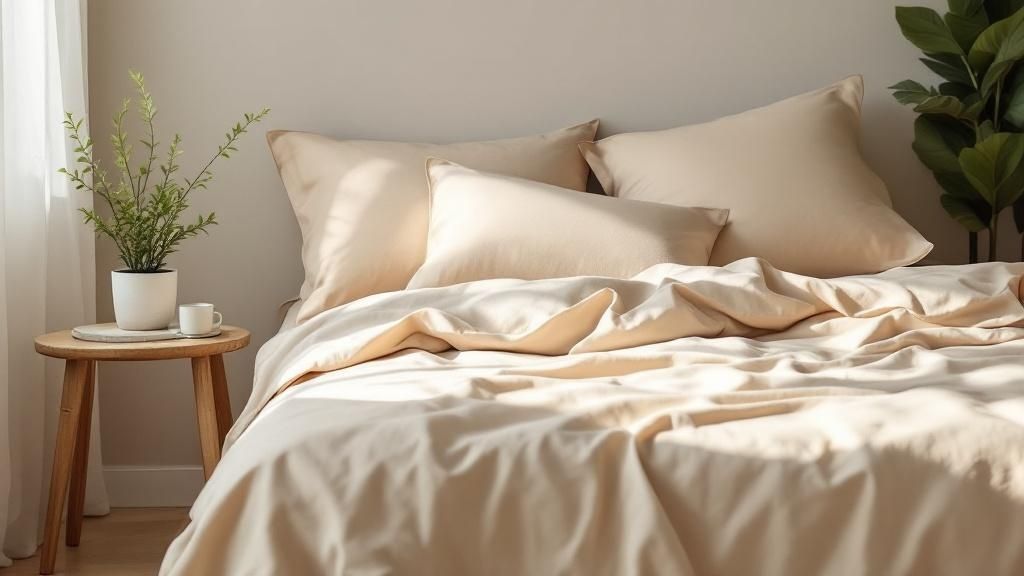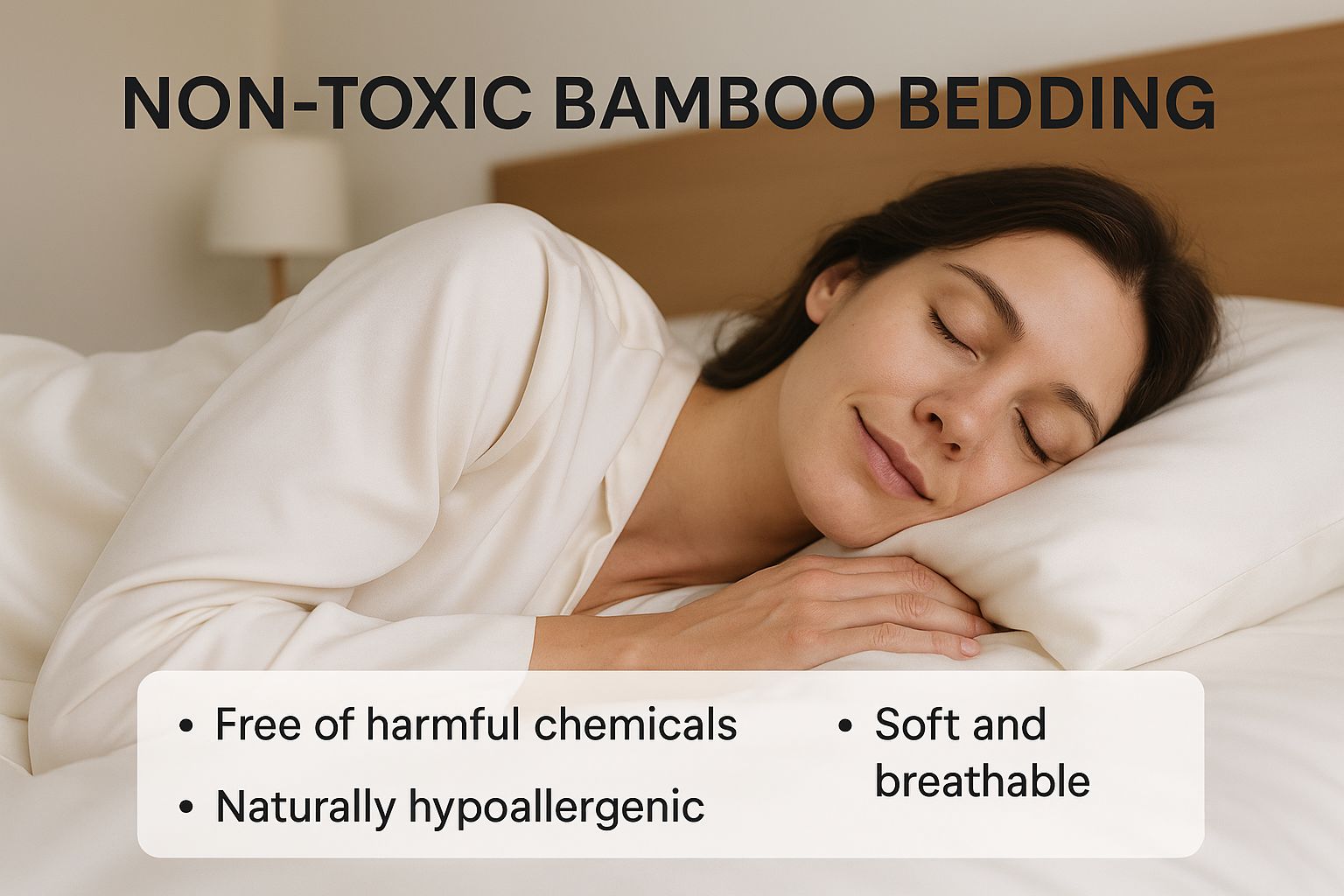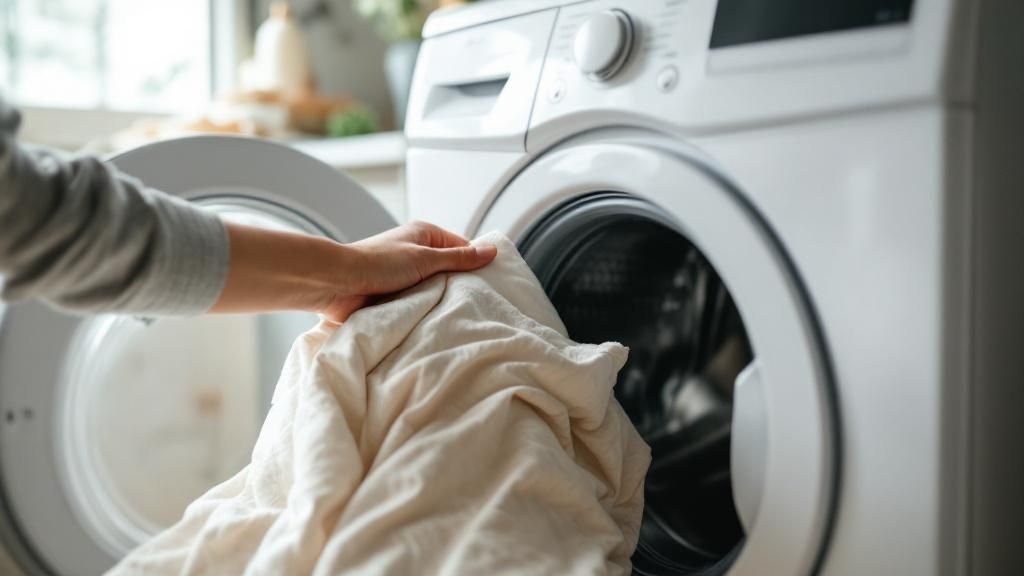Let's be real for a moment—the term "non-toxic" is everywhere these days. But what does it actually mean when it comes to your non toxic bedding? I'm not talking about marketing jargon. I'm talking about choosing materials that are genuinely free from the harsh chemicals, flame retardants, and synthetic dyes that are surprisingly common in conventional sheets and comforters.
Why Choose Non Toxic Bedding for Your Home
When you start creating a healthier home, the bedroom is the perfect place to begin. After all, you spend about a third of your life there, resting and recovering. It’s easy to forget that conventional bedding can be a source of chemical exposure, from pesticides sprayed on cotton crops to formaldehyde used to make fabrics wrinkle-free.
Think about it: your skin is your body's largest organ. Every single night, it's pressed against your sheets, pillowcases, and duvet. If those fabrics are holding onto residual chemicals, your body can absorb them while you sleep. That’s why switching to non toxic bedding isn't just a fleeting trend; it’s a smart, foundational move for a cleaner lifestyle.
The Real-World Impact on Your Health
The difference you feel from minimizing chemical exposure while you sleep can be profound. From my experience and what I've heard from others, the improvements are often quite noticeable.
Here are some of the biggest advantages:
- Less Skin Irritation: If you deal with sensitive skin, eczema, or even acne, materials like organic cotton or bamboo can be a total game-changer. They often calm things down, leading to fewer flare-ups and less redness.
- Relief from Allergies and Asthma: Many non-toxic materials are naturally hypoallergenic, meaning they resist common triggers like dust mites and mold. This can bring much-needed relief for anyone with allergies or respiratory issues.
- A Truly Restful Environment: When you get rid of chemical off-gassing, you're left with purer air in your bedroom. This simple change can contribute to deeper, more restorative sleep night after night.
This isn't just a small niche, either. The global organic bedding market was valued at around USD 936.4 million and is expected to keep growing. It's a clear sign that people are actively seeking out textiles free from harmful additives. You can read the full research on this growing market to see just how significant the trend is.
Ultimately, choosing non toxic bedding is an investment in your well-being. And once you start improving your bedroom, you might see other opportunities around your home. For example, a good guide to non-toxic carpet cleaning can help you reduce your chemical load even further. It's all about creating a sanctuary where your body can truly rest, heal, and thrive.
Decoding the Best Materials for Non Toxic Bedding

Feeling a bit lost in the sea of fabric options? You're not alone. Choosing the right material is the single most important step in finding your perfect non toxic bedding. Let's move beyond generic descriptions and talk about what it’s actually like to sleep on these materials.
This isn’t just about thread counts; it's about matching a fabric's natural properties to your personal sleep style. Your choice here can mean the difference between a restless, sweaty night and a deeply restorative one.
Organic Cotton
Organic cotton is often the first material people think of, and for good reason. It’s grown without the nasty pesticides and synthetic fertilizers that are so common in conventional cotton farming. This alone makes it a much safer choice, especially for anyone with sensitive skin or allergies.
The feel is familiar and comforting—crisp, soft, and breathable. If you love that classic hotel sheet feel but want a much healthier version for your home, GOTS-certified organic cotton is an excellent place to start. It’s a reliable, all-around performer that’s durable and easy to care for.
Linen and Hemp
For hot sleepers, linen is a true game-changer. I mean it. Made from the flax plant, its naturally hollow fibers make it incredibly breathable and moisture-wicking. It pulls heat and sweat away from your body, keeping you cool and dry even on the muggiest nights. It has a unique, slightly textured feel that only gets softer and more lived-in with every single wash.
Hemp is another powerhouse of sustainability that behaves a lot like linen. It requires very little water to grow and is naturally resistant to pests, so it doesn't need chemical intervention. Like linen, it’s exceptionally durable and breathable, making it a fantastic long-term investment for your bedding collection.
A Quick Tip from Experience: Don't be put off by the initial texture of brand-new linen or hemp sheets. They undergo a beautiful transformation, becoming noticeably softer and more luxurious after just a few wash cycles. This aging process is part of their unique charm.
Wool and Bamboo
When you hear "wool," you might picture a scratchy winter sweater, but the wool used in bedding is a completely different story. It’s a phenomenal natural insulator and temperature regulator. What does that mean for you? It helps keep you warm in the winter and, surprisingly, cool in the summer by wicking moisture away from your body. It’s also naturally flame-resistant and antimicrobial.
Then there’s bamboo viscose, another hugely popular material prized for its silky-smooth texture and impressive thermoregulating abilities. It’s often compared to high-end silk or cashmere—it’s just that soft. Because bamboo is naturally hypoallergenic and odor-resistant, it’s a wonderful choice for creating a fresh and clean sleep environment. If you want to dive deeper, you can explore the many reasons bamboo sheets are considered a superior choice for healthy sleep.
Understanding Certifications and Avoiding Greenwashing
Trying to find genuinely non toxic bedding can feel overwhelming. So many brands throw around terms like "natural" and "eco-friendly," but what do they really mean? This is where you have to learn to spot greenwashing—a marketing tactic where companies make their products seem more environmentally friendly than they actually are.
The best way to cut through the noise is by looking for third-party certifications. These labels are your proof that a product has been independently tested and meets rigorous health and safety standards. They’re the difference between a vague marketing claim and a verifiable fact.

When you know what to look for, you can rest easy, confident that your sleep space is as healthy as it is comfortable.
Key Certifications to Know
To become a savvy shopper, you just need to get familiar with a few key players in the certification world. Think of them as your non-toxic bedding cheat sheet. Each one focuses on a different part of the production process, from the farm to your bedroom.
Here are the most important ones to commit to memory:
- GOTS (Global Organic Textile Standard): This is the gold standard for organic fibers. If you see this label, it means the material itself (like cotton or wool) is certified organic. But it goes further, ensuring the entire manufacturing process is socially and environmentally responsible.
- OEKO-TEX STANDARD 100: This one is all about what touches your skin. It certifies that the final product has been tested for more than 350 harmful substances. It’s your best guarantee that your new sheets or duvet cover are free from nasty chemicals.
- Greenguard Gold: This certification zeroes in on indoor air quality. It tests for volatile organic compounds (VOCs) and guarantees that the product has extremely low chemical emissions, which is crucial for creating a healthier bedroom.
When you're trying to choose between products, these certifications can make the decision easy. Here’s a quick guide to help you compare them at a glance.
Non-Toxic Bedding Certification Cheat Sheet
| Certification | What It Guarantees | Best For |
|---|---|---|
| GOTS | The entire textile process—from harvesting organic raw materials to socially responsible manufacturing—is clean. | Ensuring your bedding is made from 100% organic fibers and produced ethically. |
| OEKO-TEX STANDARD 100 | The finished product is free from a long list of harmful chemicals and is safe for human skin. | Confirming the final product you bring home is safe, even if the raw material isn't organic. |
| Greenguard Gold | The product has very low chemical emissions (VOCs), contributing to cleaner indoor air. | People with allergies, chemical sensitivities, or anyone wanting to improve their home's air quality. |
By prioritizing products with these labels, you’re not just buying bedding; you’re investing in your health and a more sustainable industry.
This growing awareness is making a real impact. The global organic bedding market was valued at around USD 531.3 million and is expected to nearly double by 2033 as consumers demand transparency and healthier products.
Sticking to certified products is the smartest way to ensure what you're buying is truly safe. For instance, while some materials like bamboo have natural antibacterial properties, a certification confirms this benefit doesn't come with a side of toxic chemicals. You can learn more about the https://bamtekhome.com/blogs/what-are-the-antibacterial-benefits-of-bamboo-sheets in our other guides.
This same mindset can be applied throughout your home, helping you make other eco-friendly and sustainable home choices.
How to Build Your Non-Toxic Bedding Set
Switching to non-toxic bedding doesn't mean you have to toss everything and start from scratch in one expensive weekend. Frankly, that’s not practical for most of us. Think of it as a journey, not a race. The best way to build your healthy sleep sanctuary is by upgrading one piece at a time.
I always tell people to start with the layers that touch your skin the most. Your sheets and pillowcases are the obvious first step. Swapping these out first gives you the most bang for your buck in terms of health benefits, immediately cutting down on your direct exposure to any chemicals that might be in your old bedding.
From there, you can work your way outward. Once the sheets are sorted, think about the duvet cover. After that, you can look at the pillows and the comforter itself. This piecemeal approach lets you spread out the cost and really be thoughtful about each new addition to your bed.
A Practical Layering Strategy
To give you a clearer roadmap, here’s the order I usually recommend. But remember, it's just a guide—adjust it based on what works for your budget and priorities.
-
Priority 1: Sheets and Pillowcases This is your ground zero. Since they’re against your skin and face all night, choosing organic, certified materials here makes the biggest difference right away.
-
Priority 2: Duvet Cover As the next closest layer, a non-toxic duvet cover acts as a protective barrier, enclosing your current comforter while you wait to upgrade it.
-
Priority 3: Pillows and Comforter/Duvet Insert These can be a bigger investment, so tackle them when you’re ready. When the time comes, look for natural fills like organic wool, kapok, or certified latex.
-
Priority 4: Mattress Protector and Topper This is the final shield. A quality non-toxic mattress protector is fantastic because it can also help protect you from potential off-gassing if you're not ready to replace your conventional mattress just yet.
This methodical approach isn’t just a niche idea; it’s part of a much larger trend. The organic bedding market was valued at around USD 900.3 million recently and is poised for significant growth. It’s clear that people are actively moving away from materials laden with synthetic dyes and flame retardants. You can discover more about this market trend and the consumer behavior behind it.
Care Tip for Longevity: To get the most out of your new bedding, always follow the care instructions on the tag. From my experience, natural fabrics like linen or bamboo do best with a cold, gentle wash cycle and a low tumble dry. Proper care keeps them feeling soft and ensures they’ll last for years to come.
Creating a Safer Sleep Space for Your Family

When we think about creating a healthy home, the bedroom is one of the most important places to start. Choosing non-toxic bedding is a simple yet powerful way to care for your entire household. This is particularly true for babies and children, whose developing bodies are far more susceptible to the chemicals lurking in many conventional textiles.
If you’re shopping for crib sheets or bedding for your kids' room, always put certified-safe and highly breathable materials at the top of your list. Making this one change helps build a purer sleep environment, free from harsh irritants. For any parent, that kind of peace of mind is priceless.
This thoughtful approach can make a world of difference for your partner, too. If they deal with allergies, eczema, or just generally sensitive skin, switching to hypoallergenic fabrics can bring incredible relief. I've seen firsthand how materials like organic bamboo can soothe irritation and prevent flare-ups. You can dig deeper into the bamboo sheets benefits in our complete guide to better sleep.
A truly healthy sleep space is about more than just the materials you sleep on. It's a holistic effort. Think about managing light exposure, too. It’s worth looking into the role of anti-blue light glasses in promoting better sleep. Every small detail helps build a safer, more restorative sanctuary for the people you love.
Your Questions About Non-Toxic Bedding, Answered
Deciding to switch to non-toxic bedding is a fantastic step, but it's natural to have a few questions. I've heard these a lot over the years, so let's clear up some of the common concerns to help you feel great about your choice.
Is Non-Toxic Bedding Always More Expensive?
It’s true that you might notice a higher price tag upfront, but it's helpful to think of it as an investment in both your health and your wallet. High-quality, certified organic fabrics are built to last. They often hold up much better through years of use and washing compared to conventional bedding, which means you won't be replacing them nearly as often.
The good news is that as more people seek out healthier options, the market has responded. We're seeing more and more affordable non-toxic choices become available, making a healthier night's sleep a realistic goal for almost any budget.
How Can I Be Sure a Product Is Genuinely Non-Toxic?
Your best friend here is third-party certifications. Labels like OEKO-TEX, GOTS, or Greenguard are a clear sign that a product has been independently tested and verified.
But what if there's no label? This is where you have to put on your detective hat and look for radical transparency from the brand. They should be proud to tell you exactly what their products are made of. Look for specific, detailed descriptions like "100% organic French flax linen" or "viscose derived from 100% organically grown bamboo."
Vague, feel-good phrases like "eco-friendly" or "all-natural" without any proof to back them up are a red flag. A truly trustworthy company will have nothing to hide and will openly share its material sourcing and manufacturing details right on its website.
Do I Have to Replace All My Bedding at Once?
Not at all! In fact, most people find it much more manageable to make the switch gradually. It’s a marathon, not a sprint.
A smart way to start is by focusing on the layers that have the most direct contact with your skin. Begin with a new set of sheets and pillowcases. From there, you can upgrade your pillows, duvet, or mattress protector as your old ones wear out or when your budget allows. Every single swap you make adds up to a cleaner, healthier place to rest your head.
Ready to experience the difference that truly safe, luxurious bedding can make? At Bamtek, our OEKO-TEX certified sheets are crafted from 100% organic bamboo, giving you a soft, breathable, and healthy sleep you can feel good about.










